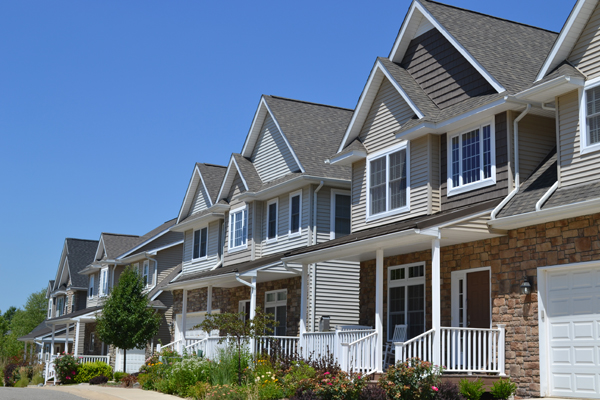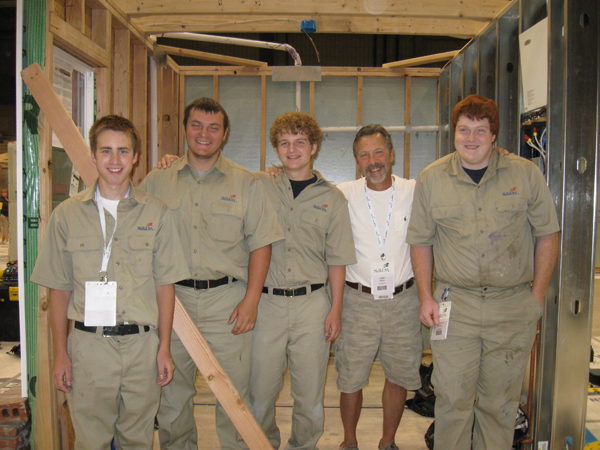
By Tara Cavanaugh
A street of stately two-story homes just off of Dhu Varren Road gleams with neatly manicured lawns and impressive stonework. Although they blend seamlessly into the rest of the development, there’s something different about the homes on Earl Shaffer Court: They were built almost entirely by Ann Arbor Public Schools students.
The students were part of the homebuilding program, a partnership between AAPS and a board of local businesses members. Each year, the program produces a class of students who learn everything about constructing a home, from laying the foundation to shingling the roof.
The program also produces and sells a home each year, and has done so for 42 years. “The homes have a reputation for being quality built, even though they’re built by students,” said Todd Griffin, board director.

The homes are built more slowly than other homes. “A lot of attention is paid to detail, and they’re being carefully supervised by professionals, teachers and subcontractors,” Griffin said. “They’re also inspected by the (City of Ann Arbor) Construction and Building Services department all along the way for code and workmanship items.”
The class of 30 students changes every year. The program admits mostly seniors and some juniors who display enough responsibility and maturity during the application process. Although students start out inexperienced, they benefit from the teachers, board members and contractors who have been involved for several years.
The board, which includes members of the legal, design, and construction fields, supplies the plans, land and materials. The contractors –– plumbers, electricians, masons–– provide extra lessons alongside the teachers.
“The contractors are selected because they’ve been involved for a long time,” Griffin said. “They are there because they’re very patient and successful working with the students.”

So how do a bunch of inexperienced students and seasoned business professionals build a home over the course of a school year?
First, there’s an airtight schedule.
“The first day of school they show up and the lot looks just like this,” John Birko, the program’s teacher said, motioning to one of the four empty lots left on Earl Shaffer Court.
“The second day there’s an excavator digging the hole. The third day, we’re putting in the footing for the basement. The fourth day we’re putting in the foundational walls for the basement. We can’t throw a day away.”
There are two classes of students, the morning class and the afternoon class, who work on the house during their first three hours of the day or the last three.
“The toughest job I have every single day is getting them to put the tools down and get back on the bus and go back to school,” Birko said. “They don’t want to quit. Once you get them going, they’ve had their lesson and they’re working, then I say it’s time to go and clean up and they say, ‘No way!’”

The days are full of lessons, practice and teambuilding. Student group leaders keep track of fellow classmates and make sure everyone’s on task. Group leaders also give a daily grade to their group members, and grade disputes must first be hashed out between leaders and students before Birko will intervene.
Birko gives weekly quizzes and a timed final performance test that includes identifying tools, building a small wall, laying out a set of stairs, and laying out a set of rafters.
Most students do well on the final exam. Birko recalls a recent student who “blew me away getting an A on that performance test. All this stuff was new to her. She didn’t want to be OK at it. She wanted to be good at this.”
That student was Ashlie Turner, who graduated from Skyline this year. She was the only girl in last year’s class.
On Turner’s first day, “I could not hammer a nail for anything,” she admits. “I struggled for like a week. But then I got the hang of it eventually.”
Turner says the practice and weekly quizzes helped a lot, and so did her teachers. “If we weren’t getting something right away, Birko would take me aside and talk me through it, give me advice. The assistant teacher (Joel Davenport) was helpful too.”
Students call Birko “Coach.” “The way he teaches, it’s like he coaches us to want to do better,” Turner said. “He pushes us to move forward and learn.”
Birko says female enrollment varies; next year five girls will participate in the program.
“Even if you’re not interested in the field, I think it’s a great hands-on experience,” Turner said. “We literally did everything: we built walls, framed them, did the electrical and plumbing, we did the tiling on the floor, we built the deck, and my favorite part was the shingling on the roof. I was really scared to get up there at first, but at the end of the day I didn’t want to come down.”
This fall Turner will attend the University of Detroit Mercy for architectural engineering. But not all of the program’s students end up going into construction-related fields.
“I’ve had so many parents come back to me later and say, this class is the best thing that ever happened to (their kids). Not because they went on and became a carpenter, a plumber, an electrician. But because they finally figured out: I have self-worth. I have real abilities. Now I figured out that I can do something.”
The program’s success is evident in the way it keeps itself funded: when a home is sold, the profits go toward purchasing more land and materials for next year’s house. Leftover profits also help fund college scholarships for a few students who excel in the program, giving up to $1,500 for four years.
The board recently purchased seven more lots on Ann Arbor’s west side. With the four undeveloped lots left on Earl Shaffer Court, that means the program will keep on going for at least another 11 years.
The program’s successful past –– and promising future ––proves that technical education is another important way to learn for many students, Birko said. “Students think the house is the goal. We straighten them out right away: the students are the goal. The house is the tool that we use.”
Related stories



1 Trackback / Pingback